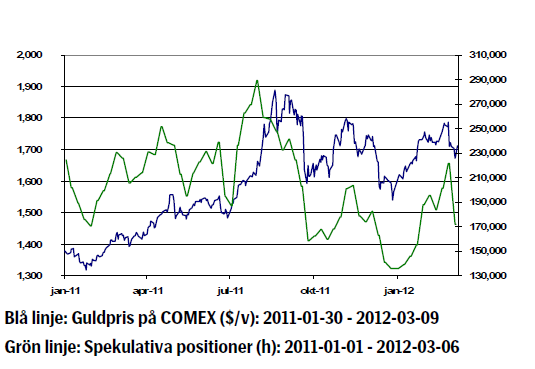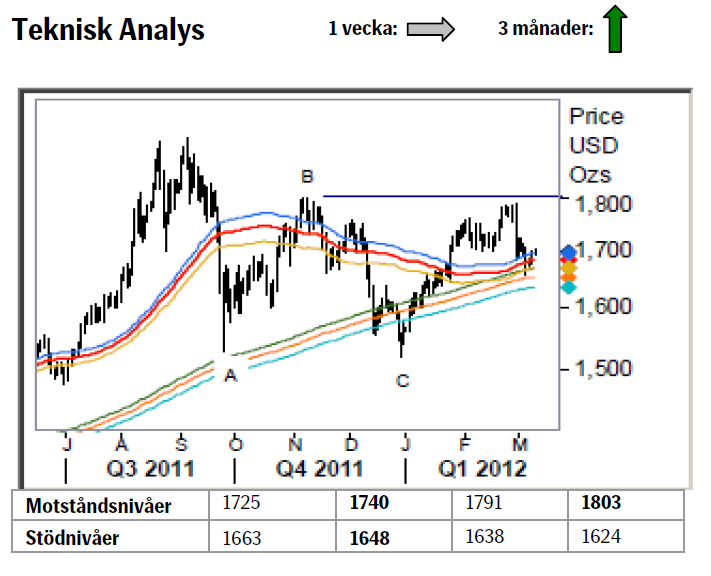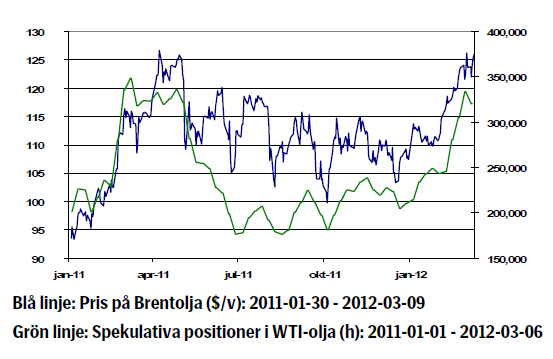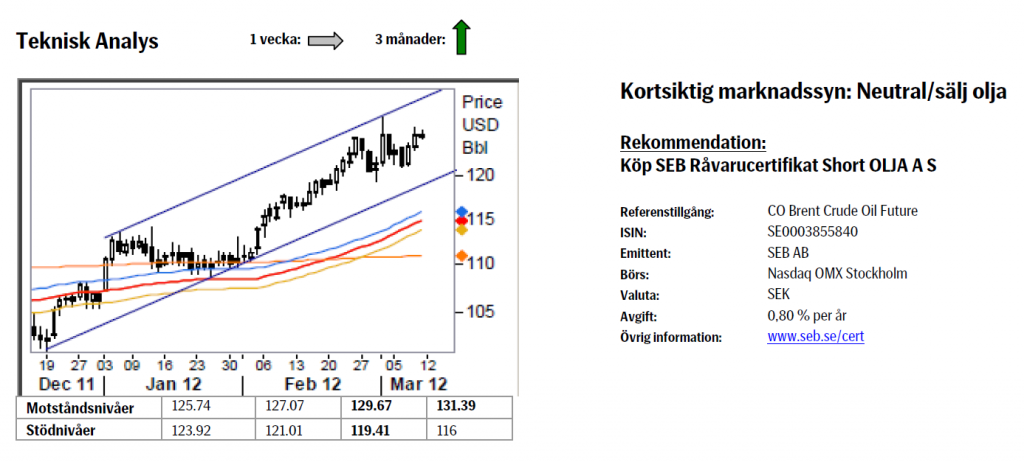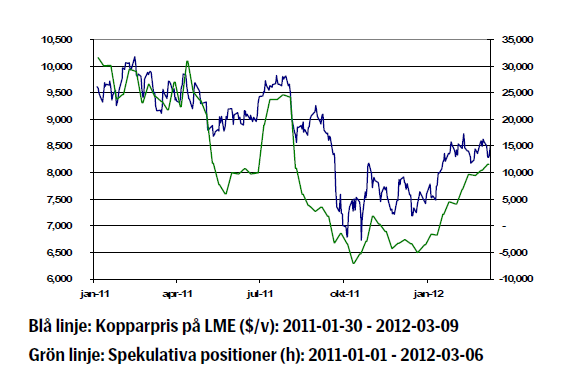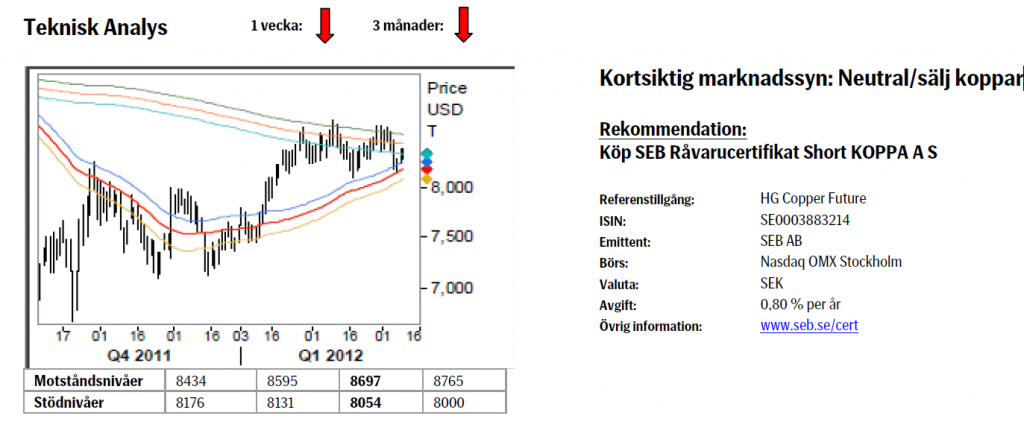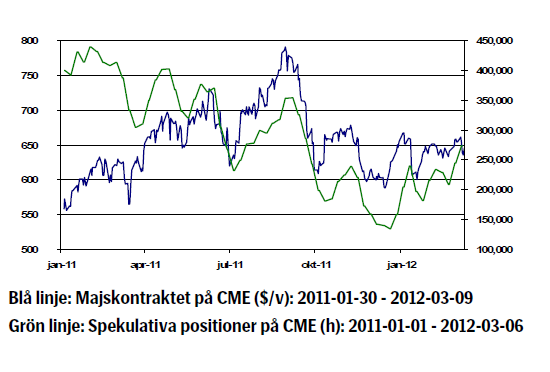Analys
SEB – Råvarukommentarer vecka 11 2012
Sammanfattning: Föregående vecka
 Brett råvaruindex: -0,96 %
Brett råvaruindex: -0,96 %
UBS Bloomberg CMCI TR Index- Energi: +1,05 %
UBS Bloomberg CMCI Energy TR Index - Ädelmetaller: -0,09 %
UBS Bloomberg CMCI Precious Metals TR Index - Industrimetaller: -2,02 %
UBS Bloomberg CMCI Industrial Metals TR Index - Jordbruk: -2,24 %
UBS Bloomberg CMCI Agriculture TR Index
Kortsiktig marknadssyn:
- Guld: Neutral
- Olja: Neutral/sälj
- Koppar: Neutral/sälj
- Majs: Neutral/köp
- Vete: Köp
Guld
- Guldpriset föll efter fredagens arbetsstatistik, vilken var något bättre än förväntat. Den amerikanska sysselsättningen utanför jordbrukssektorn ökade med 227 000 personer, totalt sett åtta procent över förväntan. Arbetslösheten låg kvar på 8,3 procent. Totalt var 12,8 miljoner människor arbetslösa i februari.
- Dollarn sjönk på beskedet och eventuellt kan siffrorna leda till att marknaden förväntar sig att FED kommer att höja räntan snabbare än den tidigare utannonserad räntebanan vill göra gällande.
- Guldet reagerade även negativt på att Kina, som av många ses som den globala ekonomins motor, sänkte sitt tillväxtmål för 2012. Detta skulle kunna indikera en minskning i landets stimulansåtgärder, något som i praktiken talar mot ett högre guldpris.
- Enligt National Bureau of Statistics har även den kinesiska guldproduktionen ökat kraftigt, men det ökade utbudet kommer till stor del att fångas upp av en stark inhemsk efterfrågan.
- ECB lämnade räntan oförändrad. Detta var helt i linje med marknadens förväntningar och innebär en fortsatt låg alternativkostnad till att hålla guld.
- Många taktiska investerare minskar nu sina innehav i guld, detta delvis som en funktion av den starka dollarn. Vi förhåller oss fortsatt neutrala till guldpriset.
- Teknisk Analys: I och med att vi hållit oss under 1740 befinner vi oss fortfarande i korrektionsfasen. Ett först försök ned i 55/233d medelvärdesbanden har avvisats något som mycket väl kan vara slutet på korrektionen och en uppgång över 1725/40 bekräftar att så är fallet. Fram till dess kvarstår dock en viss osäkerhet.
Kortsiktig marknadssyn: Neutral
Olja
- Hoppet om minskade spänningar i Mellanöstern har ökat i och med beskedet att USA, Ryssland, Kina, Storbritannien, Frankrike och Tyskland ska träffa Irans chefsförhandlare. Samtalen kommer då att röra kärnenergiprogrammet och osäkerheten är stor inför dessa möten. President Barack Obama har i sin tur sagt att det fortfarande finns utrymme för en diplomatisk lösning.
- Även de bilaterala spänningarna mellan Israel och Iran består. Israels premiärminister Netanyahu sade efter ett möte med president Obama att han inte kommer tillåta att Israel blir hotat av ett iranskt kärnvapen. I Iran svarade en ledamot i försvarsutskottet att Irans militära kapacitet har växt och att landet skulle hämnas en eventuell attack från israeliskt håll.
- Ovan nämnda situation fortsätter att prägla oljemarknaden. Skulle man mot all förmodan nå en överenskommelse skulle det minska spänningarna avsevärt.
- Den ökade andelen spekulativa köpare av olja skulle kunna förstärka rörelsen rejält vid en eventuell nedgång. Detta då ett unisont säljande skulle aktivera en mängd stoploss-nivåer.
- Vi förhåller oss svagt negativa till oljepriset denna vecka.
- Teknisk Analys: Förra veckas misslyckade försök att ta sig upp ur den stigande parallell-kanalen har vare sig lockat till något aggressivare säljande (vilket man kanske kunde ha väntat sig) eller något förnyat köpande av betydelse. Därav att vi går in i nästa vecka med en neutral vy dock med en viss faiblesse för ytterligare nedgång. Ett brott under 121 skulle utlösa en huvud skuldra topp formation och en nedgång till antingen 119 eller 116.
Kortsiktig marknadssyn: Neutral/sälj olja
Koppar
- Enligt en rådgivare till den Kinesiska centralbanken kommer fastighetspriserna att fortsätta sjunka under året, men detta innebär inte att vi får se ett stort prisfall. Regeringen kommer att fortsätta strama åt fastighetsmarknaden, men målet med åtstramningarna är en kontrollerad prisutveckling.
- Lagernivån hos London Metal Exchange är för närvarande 289 000 ton, vilken är den lägsta nivån sedan augusti 2009. Samtidigt uppvisar Shanghai både höga lagernivåer och en god kopparproduktion.
- Kinesisk statistik visar att inflationen för februari var 3,2 % vilket är 20-månaderslägsta. Detta innebär att den nu är under målet på 4 procent, något som väcker förhoppningar om kommande monetär stimulans. Enligt Kinas premiärminister förväntas Kina uppvisa en tillväxt på 7,5 procent, vilket är mindre än den åttaprocentiga tillväxt som landet alltid haft som målsättning. Enligt premiärministern kommer landet att föra en försiktig monetär politik vilket gör att marknaden kan förvänta sig ytterligare stimulans.
- Enligt CFTC ökar andelen spekulativa positioner och uppmäter nu 155 000 kontrakt, vilket är den högsta nivån sedan augusti 2011. Detta öppnar för en förstärkning av eventuella negativa prisrörelser.
- Teknisk Analys: Vi noterar, med en viss tillfredsställelse, att vi nu fått både en lägre topp samt, vilket är viktigare, en andra bortstötning från 233dagars bandet. Vi tror att detta torde vara nog för att attrahera ett tilltagande säljtryck varför vi håller en försiktig negativ vy inför nästa vecka.
Majs
- I mars månads WASDE-rapport, vilken kom ut i fredags eftermiddag, justerade det amerikanska jordbruksdepartementet (USDA) ned sin prognos något avseende de globala majslagren.
- Marknaden hade dock förväntat sig ännu svagare siffror, detta efter de senaste månadernas köldvåg runt Svarta havet samt torkan i Sydamerika.
- Totalt sett var majspriset ned under förra veckan, men fredagens rapport fick priset att komma upp en del igen innan veckan kunde summeras. Enligt ett marknadsbrev från CME hade en hel del spekulanter positionerat sig mot en nedgång i samband med rapporten, dessa aktörer hjälpte majspriset uppåt då de var tvungna att stänga ut sina positioner.
- Bortsett från den förhållandevis intetsägande rapporten för majs var det stora samtalsämnet den ökade importen från Kina under 2012. Även detta tryckte upp priserna.
- Fundamentalt sett bedömer vi att efterdyningarna efter fredagens rapport kan få priset att ligga kvar, eller till och med gå upp något denna vecka. Vi väljer att särskilt hålla ögonen på den sydamerikanska utvecklingen.
- Teknisk Analys: Försöket att bryta dödläget genom ett brott upp ur innevarande intervall misslyckades då det enda resultatet av testet blev en s.k. spik, dvs. rakt upp och rakt ned samma dag. Misslyckandet muntrade i sin tur upp säljarna som därefter lyckats pressa ned priset till 55dagars medelvärdesbandet, det primära stödet. Veckans utveckling gör att vi bibehåller en neutral vy.
Vete
- Efter att ha fallit under hela veckan kom vetepriset i Paris tillbaka ordentligt under fredagen, detta trots att prognosen på lagernivåerna i Euroland justerades upp något jämfört med förra månadens WASDE-rapport.
- På global basis reviderade USDA ned sin syn på vetelagren. Detta fick enligt ovan priset i Paris, men även i Chicago, att på fredagen återhämta sig något jämfört med föregående dagar.
- En nation vars vetebehov diskuterats flitigt i dagarna är Iran, där importen väntas bli förhållandevis stor under 2012. Faktum är att USDA:s största uppjustering av importbehovet är för Iran.
- Enligt en del analytiker börjar en mängd industriella spannmålskonsumenter nu byta från majs till vete som djurfoder, detta då vetepriset än en gång kommit ned strax under majspriset. Som referens kan nämnas att vetepriset i Chicago de senaste 10 åren i snitt varit drygt 40 procent högre än majspriset.
- Med indikationer om ett förväntat ökat behov av vete bedömer vi fundamentalt att risken för vetepriset i Paris denna vecka ligger på uppsidan. Trots att ryska källor idag har gått ut med uppgifter om goda markförhållanden för den kommande skörden tror vi inte att det kommer att kunna trycka priset nedåt denna vecka.
- Teknisk Analys: Med fortsatt bra stöd i medelvärdesbanden (samt de tidigare pekade på upprepade trevågs nedgångarna (A-B-C = korrektiva rörelser) fortsätter vi att peka på bra potential för ytterligare uppgång. Ett brott över 212.25 bör att vara den utlösande faktorn och ett brott ger vid handen ett mål uppemot 245.
[box]SEB Veckobrev Veckans råvarukommentar är producerat av SEB Merchant Banking och publiceras i samarbete och med tillstånd på Råvarumarknaden.se[/box]
Disclaimer
The information in this document has been compiled by SEB Merchant Banking, a division within Skandinaviska Enskilda Banken AB (publ) (“SEB”).
Opinions contained in this report represent the bank’s present opinion only and are subject to change without notice. All information contained in this report has been compiled in good faith from sources believed to be reliable. However, no representation or warranty, expressed or implied, is made with respect to the completeness or accuracy of its contents and the information is not to be relied upon as authoritative. Anyone considering taking actions based upon the content of this document is urged to base his or her investment decisions upon such investigations as he or she deems necessary. This document is being provided as information only, and no specific actions are being solicited as a result of it; to the extent permitted by law, no liability whatsoever is accepted for any direct or consequential loss arising from use of this document or its contents.
About SEB
SEB is a public company incorporated in Stockholm, Sweden, with limited liability. It is a participant at major Nordic and other European Regulated Markets and Multilateral Trading Facilities (as well as some non-European equivalent markets) for trading in financial instruments, such as markets operated by NASDAQ OMX, NYSE Euronext, London Stock Exchange, Deutsche Börse, Swiss Exchanges, Turquoise and Chi-X. SEB is authorized and regulated by Finansinspektionen in Sweden; it is authorized and subject to limited regulation by the Financial Services Authority for the conduct of designated investment business in the UK, and is subject to the provisions of relevant regulators in all other jurisdictions where SEB conducts operations. SEB Merchant Banking. All rights reserved.
Analys
Tightening fundamentals – bullish inventories from DOE

The latest weekly report from the US DOE showed a substantial drawdown across key petroleum categories, adding more upside potential to the fundamental picture.

Commercial crude inventories (excl. SPR) fell by 5.8 million barrels, bringing total inventories down to 415.1 million barrels. Now sitting 11% below the five-year seasonal norm and placed in the lowest 2015-2022 range (see picture below).
Product inventories also tightened further last week. Gasoline inventories declined by 2.1 million barrels, with reductions seen in both finished gasoline and blending components. Current gasoline levels are about 3% below the five-year average for this time of year.
Among products, the most notable move came in diesel, where inventories dropped by almost 4.1 million barrels, deepening the deficit to around 20% below seasonal norms – continuing to underscore the persistent supply tightness in diesel markets.
The only area of inventory growth was in propane/propylene, which posted a significant 5.1-million-barrel build and now stands 9% above the five-year average.
Total commercial petroleum inventories (crude plus refined products) declined by 4.2 million barrels on the week, reinforcing the overall tightening of US crude and products.


Analys
Bombs to ”ceasefire” in hours – Brent below $70

A classic case of “buy the rumor, sell the news” played out in oil markets, as Brent crude has dropped sharply – down nearly USD 10 per barrel since yesterday evening – following Iran’s retaliatory strike on a U.S. air base in Qatar. The immediate reaction was: “That was it?” The strike followed a carefully calibrated, non-escalatory playbook, avoiding direct threats to energy infrastructure or disruption of shipping through the Strait of Hormuz – thus calming worst-case fears.

After Monday morning’s sharp spike to USD 81.4 per barrel, triggered by the U.S. bombing of Iranian nuclear facilities, oil prices drifted sideways in anticipation of a potential Iranian response. That response came with advance warning and caused limited physical damage. Early this morning, both the U.S. President and Iranian state media announced a ceasefire, effectively placing a lid on the immediate conflict risk – at least for now.
As a result, Brent crude has now fallen by a total of USD 12 from Monday’s peak, currently trading around USD 69 per barrel.
Looking beyond geopolitics, the market will now shift its focus to the upcoming OPEC+ meeting in early July. Saudi Arabia’s decision to increase output earlier this year – despite falling prices – has drawn renewed attention considering recent developments. Some suggest this was a response to U.S. pressure to offset potential Iranian supply losses.
However, consensus is that the move was driven more by internal OPEC+ dynamics. After years of curbing production to support prices, Riyadh had grown frustrated with quota-busting by several members (notably Kazakhstan). With Saudi Arabia cutting up to 2 million barrels per day – roughly 2% of global supply – returns were diminishing, and the risk of losing market share was rising. The production increase is widely seen as an effort to reassert leadership and restore discipline within the group.
That said, the FT recently stated that, the Saudis remain wary of past missteps. In 2018, Riyadh ramped up output at Trump’s request ahead of Iran sanctions, only to see prices collapse when the U.S. granted broad waivers – triggering oversupply. Officials have reportedly made it clear they don’t intend to repeat that mistake.
The recent visit by President Trump to Saudi Arabia, which included agreements on AI, defense, and nuclear cooperation, suggests a broader strategic alignment. This has fueled speculation about a quiet “pump-for-politics” deal behind recent production moves.
Looking ahead, oil prices have now retraced the entire rally sparked by the June 13 Israel–Iran escalation. This retreat provides more political and policy space for both the U.S. and Saudi Arabia. Specifically, it makes it easier for Riyadh to scale back its three recent production hikes of 411,000 barrels each, potentially returning to more moderate increases of 137,000 barrels for August and September.
In short: with no major loss of Iranian supply to the market, OPEC+ – led by Saudi Arabia – no longer needs to compensate for a disruption that hasn’t materialized, especially not to please the U.S. at the cost of its own market strategy. As the Saudis themselves have signaled, they are unlikely to repeat previous mistakes.
Conclusion: With Brent now in the high USD 60s, buying oil looks fundamentally justified. The geopolitical premium has deflated, but tensions between Israel and Iran remain unresolved – and the risk of missteps and renewed escalation still lingers. In fact, even this morning, reports have emerged of renewed missile fire despite the declared “truce.” The path forward may be calmer – but it is far from stable.
Analys
A muted price reaction. Market looks relaxed, but it is still on edge waiting for what Iran will do

Brent crossed the 80-line this morning but quickly fell back assigning limited probability for Iran choosing to close the Strait of Hormuz. Brent traded in a range of USD 70.56 – 79.04/b last week as the market fluctuated between ”Iran wants a deal” and ”US is about to attack Iran”. At the end of the week though, Donald Trump managed to convince markets (and probably also Iran) that he would make a decision within two weeks. I.e. no imminent attack. Previously when when he has talked about ”making a decision within two weeks” he has often ended up doing nothing in the end. The oil market relaxed as a result and the week ended at USD 77.01/b which is just USD 6/b above the year to date average of USD 71/b.

Brent jumped to USD 81.4/b this morning, the highest since mid-January, but then quickly fell back to a current price of USD 78.2/b which is only up 1.5% versus the close on Friday. As such the market is pricing a fairly low probability that Iran will actually close the Strait of Hormuz. Probably because it will hurt Iranian oil exports as well as the global oil market.
It was however all smoke and mirrors. Deception. The US attacked Iran on Saturday. The attack involved 125 warplanes, submarines and surface warships and 14 bunker buster bombs were dropped on Iranian nuclear sites including Fordow, Natanz and Isfahan. In response the Iranian Parliament voted in support of closing the Strait of Hormuz where some 17 mb of crude and products is transported to the global market every day plus significant volumes of LNG. This is however merely an advise to the Supreme leader Ayatollah Ali Khamenei and the Supreme National Security Council which sits with the final and actual decision.
No supply of oil is lost yet. It is about the risk of Iran closing the Strait of Hormuz or not. So far not a single drop of oil supply has been lost to the global market. The price at the moment is all about the assessed risk of loss of supply. Will Iran choose to choke of the Strait of Hormuz or not? That is the big question. It would be painful for US consumers, for Donald Trump’s voter base, for the global economy but also for Iran and its population which relies on oil exports and income from selling oil out of that Strait as well. As such it is not a no-brainer choice for Iran to close the Strait for oil exports. And looking at the il price this morning it is clear that the oil market doesn’t assign a very high probability of it happening. It is however probably well within the capability of Iran to close the Strait off with rockets, mines, air-drones and possibly sea-drones. Just look at how Ukraine has been able to control and damage the Russian Black Sea fleet.
What to do about the highly enriched uranium which has gone missing? While the US and Israel can celebrate their destruction of Iranian nuclear facilities they are also scratching their heads over what to do with the lost Iranian nuclear material. Iran had 408 kg of highly enriched uranium (IAEA). Almost weapons grade. Enough for some 10 nuclear warheads. It seems to have been transported out of Fordow before the attack this weekend.
The market is still on edge. USD 80-something/b seems sensible while we wait. The oil market reaction to this weekend’s events is very muted so far. The market is still on edge awaiting what Iran will do. Because Iran will do something. But what and when? An oil price of 80-something seems like a sensible level until something do happen.
-

 Nyheter3 veckor sedan
Nyheter3 veckor sedanStor uppsida i Lappland Guldprospekterings aktie enligt analys
-

 Nyheter4 veckor sedan
Nyheter4 veckor sedanBrookfield ska bygga ett AI-datacenter på hela 750 MW i Strängnäs
-

 Nyheter4 veckor sedan
Nyheter4 veckor sedanSommaren inleds med sol och varierande elpriser
-

 Nyheter3 veckor sedan
Nyheter3 veckor sedanSilverpriset släpar efter guldets utveckling, har mer uppsida
-

 Analys4 veckor sedan
Analys4 veckor sedanBrent needs to fall to USD 58/b to make cheating unprofitable for Kazakhstan
-

 Nyheter4 veckor sedan
Nyheter4 veckor sedanTradingfirman XTX Markets bygger datacenter i finska Kajana för 1 miljard euro
-

 Nyheter2 veckor sedan
Nyheter2 veckor sedanUppgången i oljepriset planade ut under helgen
-

 Nyheter2 veckor sedan
Nyheter2 veckor sedanLåga elpriser i sommar – men mellersta Sverige får en ökning


